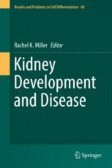Search
Search Results
-
Methamphetamine-induced changes in myocardial gene transcription are sex-dependent
BackgroundPrior work demonstrated that female rats (but not their male littermates) exposed to methamphetamine become hypersensitive to myocardial...

-
Extracellular RNA in renal diseases
The discovery of extracellular RNA (exRNA) in blood and bodily fluids has expended our knowledge on RNA functions. ExRNAs may be transferred between...
-
The critical role of the interplays of EphrinB2/EphB4 and VEGF in the induction of angiogenesis
The significant role of VEGF (vascular endothelial growth factor) as an angiogenesis inducer is well recognized. Besides VEGF, EphrinB2/EphB4 also...

-
Mutational screening of
PKD2 gene in the north Indian polycystic kidney disease patients revealed 28 genetic variationsPolycystic kidney disease (PKD) is a systemic disorder which adds majority of renal patients to end stage renal disease. Autosomal dominant...

-
A role for polycystin-1 and polycystin-2 in neural progenitor cell differentiation
Polycystin-1 (PC1) and polycystin-2 (PC2) are transmembrane proteins encoded by the Pkd1 and Pkd2 genes, respectively. Mutations in these genes are...

-
Human reconstructed kidney models
The human kidney, which consists of up to 2 million nephrons, is critical for blood filtration, electrolyte balance, pH regulation, and fluid balance...

-
Mitochondrial microRNA (MitomiRs) in cancer and complex mitochondrial diseases: current status and future perspectives
Mitochondria are not only important for cellular bioenergetics but also lie at the heart of critical metabolic pathways. They can rapidly adjust...

-
Transient Receptor Potential (TRP) Channels
Transient Receptor Potential (TRP) channels are evolutionarily conserved integral membrane proteins. The mammalian TRP superfamily of ion channels...
-
Mass Spectrometry-Based Analysis of TRPP2 Phosphorylation
Differential phosphorylation of proteins is a key regulatory mechanism in biology. Immunoprecipitation-coupled mass spectrometry facilitates the...
-
Metabolic perturbations caused by depletion of nephronophthisis factor Anks6 in mIMCD3 cells
IntroductionNephronophthisis (NPH) is an inherited form of cystic kidney disease with various extrarenal manifestations accounting for the largest...

-
Implications of microRNA in kidney metabolic disorders
The kidney requires large amount of energy to regulate the balance of fluid, electrolytes and acid-base homeostasis. Mitochondria provide...

-
Zebrafish heart failure models: opportunities and challenges
Heart failure is a complex pathophysiological syndrome of pum** functional failure that results from injury, infection or toxin-induced damage on...

-
Structure of the polycystic kidney disease TRP channel Polycystin-2 (PC2)
Mutations in either polycystin-1 (PC1 or PKD1) or polycystin-2 (PC2, PKD2 or TRPP1) cause autosomal-dominant polycystic kidney disease (ADPKD)...

-
Organellar TRP channels
Mammalian transient receptor potential (TRP) channels mediate Ca 2+ flux and voltage changes across membranes in response to environmental and...

-
Ouabain Regulates CFTR-Mediated Anion Secretion and Na,K-ATPase Transport in ADPKD Cells
Cyst enlargement in autosomal dominant polycystic kidney disease (ADPKD) requires the transepithelial secretion of fluid into the cyst lumen. We...

-
Stem cell-derived kidney organoids: engineering the vasculature
Kidney organoids can be generated from human pluripotent stem cells (PSCs) using protocols that resemble the embryonic development of the kidney. The...

-
Inflammation and Fibrosis in Polycystic Kidney Disease
Polycystic kidney disease (PKD) is a commonly inherited disorder characterized by cyst formation and fibrosis (Wilson, N Engl J Med 350:151–164,...
-
Quantification of angiotensin II-regulated proteins in urine of patients with polycystic and other chronic kidney diseases by selected reaction monitoring
BackgroundAngiotensin-II (Ang II) mediates progression of autosomal-dominant polycystic kidney disease (ADPKD) and other chronic kidney diseases...

-
Chronic exposure to ethylenethiourea induces kidney injury and polycystic kidney in mice
BackgroundsEthylenethiourea (ETU) is one of the main metabolite of ethylenebisdithiocarbamate fungicides and potential exposure is highest for...
-
Erythrocyte glutathione transferase in kidney transplantation: a probe for kidney detoxification efficiency
Erythrocyte glutathione transferase (e-GST) is overexpressed in case of increased blood toxicity and its level correlates with the kidney disease...

